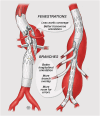Physiology of bridging stent grafts after fenestrated/branched endovascular aortic repair: Where translational science meets the clinical profile
- PMID: 39871623
- PMCID: PMC11868031
- DOI: 10.1113/EP091813
Physiology of bridging stent grafts after fenestrated/branched endovascular aortic repair: Where translational science meets the clinical profile
Abstract
Fenestrated/branched endovascular aortic repair emerges as the primary therapeutic modality for intricate aortic pathologies encompassing the paravisceral and thoracoabdominal segments, where bridging stent grafts (BSGs) play a vital role in linking the primary aortic endograft with target vessels. Bridging stent grafts can be categorized mainly into self-expanding stent grafts (SESGs) and balloon-expandable stent grafts (BESGs). Physiological factors significantly influence post-complex endovascular aortic repair BSG behaviour, impacting clinical outcomes of SESGs and BESGs in different but overlapping ways. Crucial prerequisites for BSGs encompass not only flexibility but also resilience against mechanical stress and compliance mismatch, especially when bridging the rigid aortic main body with dynamic target vessels. The significance of considering these physiological factors in clinical decision-making is underscored by recognizing the interplay between SESG and BESG characteristics, vessel physiology and patient haemorheology. Such factors include the anatomy and tortuosity of the vessel, diameter of the vessel and BSG, deployment and durability, extrinsic stenosis and respiratory motion. Haemorheological factors, such as anti-thrombotic therapy and hydration status, need to be considered. This narrative review examines both in vitro and in vivo evidence regarding the impact of physiological factors on the behaviour of BSGs and assesses the consequences for clinical outcomes following complex endovascular aortic repair.
Keywords: balloon‐expandable; branched; bridging stent graft; complex endovascular aortic repair endovascular aortic repair; endovascular aortic repair; fenestrated; haemorheology; self‐expanding; vessel physiology.
© 2024 The Author(s). Experimental Physiology published by John Wiley & Sons Ltd on behalf of The Physiological Society.
Conflict of interest statement
The authors declare no conflicts of interest.
Figures
References
-
- Abbott . (2023). Graftmaster RX stent coronary graft system. Abbott. Retrieved Dec 16, 2023. https://www.cardiovascular.abbott/us/en/hcp/products/percutaneous‐corona...
-
- Asciutto, G. , Ibrahim, A. , Leone, N. , Gennai, S. , Piazza, M. , Antonello, M. , Wanhainen, A. , Mani, K. , Lindström, D. , Struk, L. , & Oberhuber, A. (2024). Intravascular ultrasound in the detection of bridging stent graft instability during fenestrated and branched endovascular aneurysm repair procedures: A multicentre study on 274 target vessels. European Journal of Vascular and Endovascular Surgery, 67(1), 99–104. - PubMed
-
- BD . (2023). Covera vascular covered stents—Product information. BD. Retrieved December 16, 2023. https://www.bd.com/en‐us/products‐and‐solutions/products/product‐familie...
-
- Bekken, J. A. , Vroegindeweij, D. , Vos, J. A. , de Vries, J. P. M. , Lardenoije, J. W. H. P. , Petri, B. J. , Pierie, M. E. N. , van Weel, V. , Teijink, J. A. W. , & Fioole, B. (2022). Two year results of the randomised DISCOVER trial comparing covered versus bare metal stents in the common iliac artery. European Journal of Vascular and Endovascular Surgery: The Official Journal of the European Society for Vascular Surgery, 65(3), 359–368. - PubMed
-
- Bia, D. , Galli, C. , Valtuille, R. , Zócalo, Y. , Wray, S. A. , Armentano, R. L. , & Cabrera Fischer, E. I. (2015). Hydration status is associated with aortic stiffness, but not with peripheral arterial stiffness, in chronically hemodialysed patients. International Journal of Nephrology, 2015, 628654. - PMC - PubMed
Publication types
MeSH terms
Grants and funding
LinkOut - more resources
Full Text Sources
Miscellaneous

